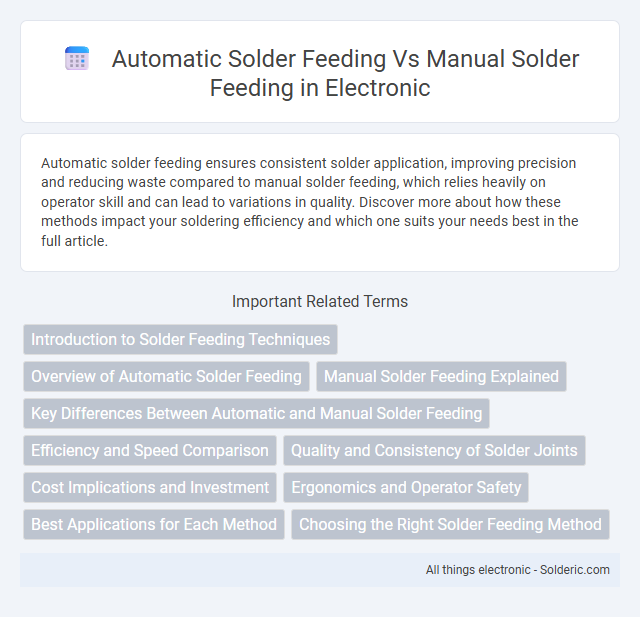Automatic solder feeding ensures consistent solder application, improving precision and reducing waste compared to manual solder feeding, which relies heavily on operator skill and can lead to variations in quality. Discover more about how these methods impact your soldering efficiency and which one suits your needs best in the full article.
Comparison Table
| Feature | Automatic Solder Feeding | Manual Solder Feeding |
|---|---|---|
| Efficiency | High - Continuous feed minimizes downtime | Low - Frequent pauses for manual adjustment |
| Consistency | Precise and uniform solder application | Variable - Depends on operator skill |
| Speed | Fast - Automated control accelerates process | Slower - Manual pace limits throughput |
| Labor Requirements | Low - Minimal operator intervention | High - Requires constant attention |
| Cost | High initial investment; lower long term | Low initial cost; potentially higher labor cost |
| Control | Precise digital control settings | Depends on operator experience |
| Maintenance | Requires periodic machine servicing | Minimal, mainly tool upkeep |
| Application | Best for high-volume, repetitive tasks | Better for small batches and prototyping |
Introduction to Solder Feeding Techniques
Automatic solder feeding systems ensure a consistent and precise supply of solder wire, reducing human error and increasing production efficiency in electronics manufacturing. Manual solder feeding relies on operator skill, allowing for greater control in delicate or custom applications but with potential variability and slower throughput. Advances in automatic feeders include programmable settings and real-time monitoring, optimizing solder application for both volume production and complex assemblies.
Overview of Automatic Solder Feeding
Automatic solder feeding systems improve precision and efficiency by continuously supplying solder wire during the soldering process, reducing operator fatigue and increasing production speed. These systems maintain consistent solder flow, minimizing defects and ensuring uniform joint quality, which is critical in high-volume manufacturing environments such as PCB assembly. Compared to manual solder feeding, automatic feeders offer enhanced control, reduced material waste, and better repeatability, making them essential for meeting stringent quality standards.
Manual Solder Feeding Explained
Manual solder feeding involves the operator physically controlling the amount and speed of solder wire supplied to the joint, which requires skill and precision to maintain consistent quality. This method allows for greater flexibility in handling complex or delicate soldering tasks, making it ideal for custom or small-scale production. However, manual feeding can lead to variability in solder application and slower production rates compared to automatic systems, impacting overall efficiency.
Key Differences Between Automatic and Manual Solder Feeding
Automatic solder feeding offers consistent wire delivery and precise control, reducing human error and increasing production efficiency. Manual solder feeding requires skilled operators to manage wire placement and speed, leading to potential inconsistencies and slower throughput. Your choice depends on production volume and accuracy needs, with automatic systems favored for high-demand, repetitive tasks.
Efficiency and Speed Comparison
Automatic solder feeding systems significantly enhance efficiency by consistently delivering precise solder amounts, reducing material waste and minimizing operator fatigue. These systems operate at higher speeds compared to manual solder feeding, enabling faster production cycles and improving overall throughput in electronics manufacturing. Manual solder feeding often results in slower application rates and variable solder placement, leading to increased rework and decreased process reliability.
Quality and Consistency of Solder Joints
Automatic solder feeding ensures consistent solder joint quality by precisely controlling the amount and placement of solder, reducing defects caused by human error. Manual solder feeding often results in variability due to inconsistent application and operator fatigue, leading to weaker or uneven joints. Investing in automatic solder feeding can significantly improve the reliability of your electronic assemblies by enhancing joint uniformity and minimizing rework.
Cost Implications and Investment
Automatic solder feeding systems require a higher initial investment compared to manual solder feeding, but they significantly reduce labor costs over time by increasing efficiency and minimizing waste. Manual solder feeding demands less upfront capital but incurs ongoing expenses due to slower production rates and higher material consumption. Long-term cost savings and improved consistency often justify the upfront cost of automatic solder feeding for industrial-scale operations.
Ergonomics and Operator Safety
Automatic solder feeding systems significantly improve ergonomics by reducing repetitive wrist and hand movements commonly associated with manual solder feeding, lowering the risk of musculoskeletal disorders among operators. These systems also enhance operator safety by minimizing direct contact with hot soldering components and fumes, thus decreasing the likelihood of burns and inhalation hazards. In contrast, manual solder feeding often leads to increased fatigue and exposure to harmful substances, negatively impacting worker health and productivity.
Best Applications for Each Method
Automatic solder feeding excels in high-volume production environments such as PCB assembly lines, where consistent solder delivery improves efficiency and minimizes human error. Manual solder feeding is best suited for small-scale, precision work like prototype development, repair tasks, and custom electronics, offering greater control and flexibility. Each method optimizes solder application based on production scale, accuracy needs, and operator skill level.
Choosing the Right Solder Feeding Method
Choosing the right solder feeding method depends on production volume, precision requirements, and cost efficiency. Automatic solder feeding ensures consistent solder delivery, reduces material waste, and improves joint quality in high-volume or complex assembly lines. Manual solder feeding offers flexibility and lower upfront costs, making it suitable for prototyping, small runs, or applications with varying soldering needs.
automatic solder feeding vs manual solder feeding Infographic

 solderic.com
solderic.com